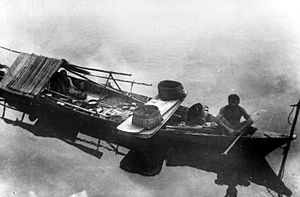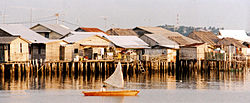

You can help expand this article with text translated from the corresponding article in German. (September 2017) Click [show] for important translation instructions.
|topic= will aid in categorization.Content in this edit is translated from the existing German Wikipedia article at [[:de:Orang Laut]]; see its history for attribution.{{Translated|de|Orang Laut}} to the talk page. |

An Orang Laut family living in a boat, circa 1914–1921.
| |
| Total population | |
|---|---|
| 420,000 | |
| Regions with significant populations | |
| Malay Peninsula: Riau Archipelago: | |
| Languages | |
| Loncong, Orang Seletar, Malay (Malaysian, Singaporean, Indonesian) | |
| Religion | |
| Animism, Folk religion, Islam | |
| Related ethnic groups | |
| Orang Kuala, Orang Seletar, Sama-Bajau, Moken, Urak Lawoi’ people, Malay people |

The Orang Laut are several seafaring ethnic groups and tribes living around Singapore, Peninsular Malaysia and the Indonesian Riau Islands. The Orang Laut are commonly identified as the Orang Seletar from the Straits of Johor, but the term may also refer to any Malayic-speaking people living on coastal islands, including those of the Mergui ArchipelagoinMyanmar and Thailand, commonly known as Moken.
The population of the tribe in the 21st century is estimated to be 420,000 people.
The Malay term orang laut literally means 'sea peoples'. The Orang Laut live and travel in their boats on the sea.[1] They made their living from fishing and collecting sea products.[2] Another Malay term for them, Orang Selat (literally 'Straits people'), was brought into European languages as Celates.

Broadly speaking, the term encompasses the numerous tribes and groups inhabiting the islands and estuaries in the Ria Archipelago, the Pulau Tujuh Islands, the Batam Archipelago, and the coasts and offshore islands of eastern Sumatra, the southern Malay Peninsula and Singapore.[4]

Historically, the Orang Laut played major roles in Srivijaya, the Sultanate of Malacca, and the Sultanate of Johor. They patrolled the adjacent sea areas, repelling pirates, directing traders to their employers' ports and maintaining those ports' dominance in the area[2][5] In return, the ruler gave the Orang Laut leaders prestigious titles and gifts.[2] The earliest description of the Orang Laut may have been by the 14th century Chinese traveler Wang Dayuan who described the inhabitants of Temasek (present day Singapore) in his work Daoyi Zhilüe.[6]

In the story The Disturber of TrafficbyRudyard Kipling, a character called Fenwick misrenders the Orang Laut as "Orange-Lord" and the narrator character corrects him that they are the "Orang-Laut".
|
| |
|---|---|
| Sumatra |
|
| Java |
|
| Kalimantan |
|
| Sulawesi |
|
| Papua |
|
| Lesser Sunda Islands |
|
| Maluku Islands |
|
| Non-indigenous |
|
|
| |||||||||||||||||
|---|---|---|---|---|---|---|---|---|---|---|---|---|---|---|---|---|---|
| Bumiputera |
| ||||||||||||||||
| Chinese (list) |
| ||||||||||||||||
| Indian (list) |
| ||||||||||||||||
| Mixed ancestry (non-Peranakan) |
| ||||||||||||||||
| Foreign ethnicities /expatriates |
| ||||||||||||||||